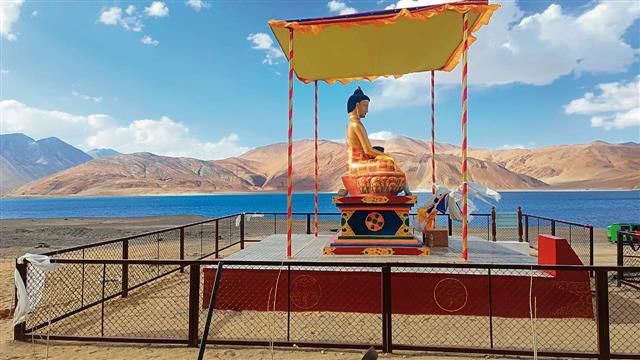New LAC action: Buddha statues at 1962 India-China battle sites
Ajay Banerjee
New Delhi, July 7
As armies of India and China maintain their respective positions along the Line of Actual Control (LAC) in eastern Ladakh, New Delhi, in an apparent psychological operation (psyop), has added an element of “faith” and “reverence” by installing statues of Lord Buddha at two LAC hotspots —Lukung and Chushul.
The statues have been installed as part of the “developmental effort” under the government’s “Vibrant Village Programme”.
Both Lukung and Chushul stood witness to bloody battles during the 1962 India-China war. The Indian troops held back the Chinese at both these places.
2 unveiled, 2 on cards
- Statues showing Buddha in Bhumisparsha Mudra were unveiled at Lukung & Chushul along the LAC last week
- Two more similar statues will also come up; one of these at Demchok, while the location for the other is yet to be finalised
Similar statues are planned to be installed at two more locations. One of these will be installed at Demchok, while the location for the other one is yet to be decided, sources maintain.
The statues at Lukung and Chushul were unveiled last week with Army officials and the local population in attendance. Indian Army’s 14 Corps put out a post on X yesterday with a video of the statues, besides mentioning: “Upholding essence of Vasudhaiva Kutumbakam (the world is one family) to foster solidarity, preserve spiritual values and eternal peace in forward areas of eastern Ladakh.”
The locations of the statues are significant. Lukung is on the north-western edge of Pangong Tso, while the statue at Chushul faces the Spanggur Gap, the border meeting point of the two armies. The Chinese garrison of Moldo is around 8 km from there.
History of the Conflict with China-1962, a book released for “restricted” circulation by the Ministry of Defence (MoD) in March 1993, tells how Indian troops held on in Ladakh, most notably at Rezang La in eastern Ladakh, 5 km south-east of Chusul hamlet.
“The Indian soldier was defeated but not disgraced in Ladakh,” it said. Lukung is near “Finger 4” on the north bank of Pangong Tso where the Chinese had been held back by the Indian Army in 1962.
According to the video released by 14 Corps, the statues show Lord Buddha in “Bhumisparsha Mudra”. Stanford University’s newsletter “Mudras of the Great Buddha: Symbolic Gestures and Postures” describes the “Bhumisparsha Mudra” as “touching the earth”. “It symbolises Buddha’s enlightenment under the Bodhi Tree, when he summoned earth goddess Sthavara to bear witness to his attainment of enlightenment,” it adds.
“Guns, tanks, missiles and troops will remain at their existing locations. The statues of the apostle of non-violence (Buddha) are not indicative of any change in our military and diplomatic stance,” said an official.
External Affairs Minister S Jaishankar held a meeting with his Chinese counterpart Wang Yi on the sidelines of the SCO Summit at Astana in Kazakhstan on July 4.
A statement said: “The two ministers had an in-depth exchange of views on finding an early resolution of the remaining issues along the LAC in eastern Ladakh to stabilise and rebuild bilateral relations.”
An official said the statues were also an attempt to bolster the morale of Ladakhi Buddhists residing here for centuries. “The Great Game in the Buddhist Himalayas”, former diplomat Phunchok Stobdan’s book that was published in 2019, says: “Modern-day Buddhism in the Himalayas is influenced by ‘Tibetenisation’. The book mentions how the Indian Buddhist tradition of Nalanda and Vikramshila practised by Sakyas and Vajracharyas is being allowed to die down. There was no effort to sustain the Indian Buddhist tradition.”









